Piliocolobus bouvieri
IUCN
LCBasic Information
Scientific classification
- name:Piliocolobus bouvieri
- Scientific Name:Piliocolobus bouvieri,Bouvier’s Red Colobus
- Outline:Primates
- Family:Cercopithecidae R.Colobus
Vital signs
- length:45-67cm
- Weight:About 4.5kg
- lifetime:No verification information
Feature
Distribution and Habitat
Distributed on the right bank of the Congo River, along the lower reaches of the Alima River to the mouth of the Likouala River (Likouala-aux-Herbes), west of the Sangha River, the lower tributaries of the Congo River and the Republic of Congo.
Inhabits coastal forests and waterways with native vegetation.
Appearance
The Bouvier's Red Colobus has a slender body, with a head-body length of 45-67 cm, a tail length of 52-80 cm, and a weight of about 4.5 kg. Like other colobus species, the anal warts are small, the tail is long, and the cheek pouches are smaller than those of ordinary monkeys. They are different from leaf monkeys in that they have no thumbs, although the other fingers are particularly long, and the thumbs have degenerated into a small wart, hence the name colobus. The Bouvier's Red Colobus is different from other species of the same genus. The whole body is covered with long hair and there are no tufts. The bright colors are very attractive. The head, upper body, arms and legs are mainly brown, red or chestnut, the chest and abdomen are grayish white, and there are thick white beards around the black face. The fur around the pubic area is white. The genitals of subadults of both sexes are swollen like those of females, probably to prevent the males from being expelled from th
Details
Bouvier’s Red Colobus (scientific name: Piliocolobus bouvieri), also known as Bouvier’s Red Colobus in English, was once a subspecies of the West African red colobus or the Przewalski’s red colobus. It was identified as an independent species in 2013.

The Bouvier red colobus monkey is a diurnal animal. It is arboreal and moves quickly between species. The complex structure of its stomach has been adapted to digest leaves. It is a complete vegetarian, eating large amounts of leaves every day, and occasionally eating fruits, mosses and seeds, with a daily food intake of up to 2-3 kg. It also eats soil and charcoal to help digest toxins on the leaves.
The distribution range of the Bouvier red colobus monkey is very limited, which is limited to the Congo River Basin between 3ºS south latitude and 15º30'E longitude. It was once thought to be extinct in the wild. The number of wild surviving monkeys is limited. The main threats are habitat destruction, reduced precipitation, the local original forests are almost completely replaced by cultivated crops, tourism impact, road development, and changes in the living environment. Another reason is that the local Tu people hunt monkeys in large numbers for meat. It has been listed as a critically endangered species.
Listed in the 2016 Red List of Endangered Species of the World Conservation Union (IUCN) ver 3.1 - Critically Endangered (CR).
Protect wild animals and stop eating game.
Maintaining ecological balance is everyone's responsibility!








